
USS Talladega (APA/LPA-208) was a Haskell-class attack transport of the US Navy. She was of the VC2-S-AP5 Victory ship design type. Talladega was named for Talladega County, Alabama.

USS Paul Revere (APA/LPA-248) was the lead ship of the Paul Revere class of attack transport in the United States Navy. She was named for the early patriot and Founding Father, Paul Revere (1735–1818). She later served in the Spanish Navy as Castilla (L-21).

USS Tulare (AKA-112/LKA-112) was a Tulare-class attack cargo ship in service with the United States Navy from 1956 to 1986. She was sold for scrap in 2011.

USS Lenawee (APA-195) was a Haskell-class attack transport in service with the United States Navy from 1944 to 1946 and from 1950 to 1967. She was scrapped in 1975.
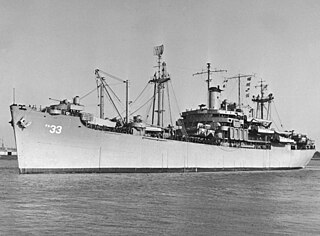
USS Bayfield (APA-33) was a Bayfield-class attack transport built for the United States Navy during World War II, the lead ship in her class. Named for Bayfield County, Wisconsin, she was the only U.S. Naval vessel to bear the name.

USS Pickaway (APA/LPA-222) was a Haskell-class attack transport that saw service with the US Navy in World War II, the Korean War and the Vietnam War. She was of the VC2-S-AP5 Victory ship design type and named after Pickaway County, Ohio.

USS Hickman County (LST-825) was an LST-542-class tank landing ship built for the United States Navy during World War II. Named after counties in Kentucky and Tennessee, she was the only U.S. Naval vessel to bear the name.
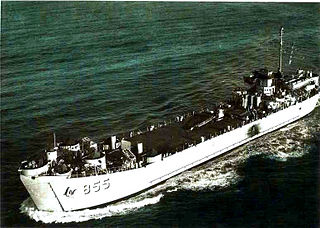
USS Kent County (LST-855) was an LST-542-class tank landing ship built for the United States Navy during World War II. Named after counties in Delaware, Maryland, Michigan, Rhode Island, and Texas, she was the only U.S. Naval vessel to bear the name.

USS Chilton (APA-38) was a Bayfield-class attack transport. Her task was to deliver troops to the battle front, and to recover and care for the wounded. She served in the Pacific Ocean in the war against the Empire of Japan and returned home post-war with one battle star to her credit.

USS Rockingham (APA/LPA-229) was a Haskell-class attack transport in service with the United States Navy from 1944 to 1947. She was scrapped in 1979.

USS Sandoval (APA-194/LPA-194) was a Haskell-class attack transport in service with the United States Navy from 1944 to 1946, from 1951 to 1955 and from 1961 to 1970. She was scrapped in 1983.

USS Henrico (APA-45) was a Bayfield-class attack transport that served with the United States Navy in World War II, and subsequently in the Korean War, Cold War and Vietnam War.

USS St. Clair County (LST-1096) was a LST-542-class tank landing ship built for the United States Navy in World War II. Like most of the ships of her class she was originally known only by her designation, USS LST-1096, and, like all remaining LSTs, was renamed on 1 July 1955. She was named for counties in Alabama, Illinois, Michigan, and Missouri.

USS Telfair (APA/LPA-210) was a Haskell-class attack transport that saw service with the US Navy in World War II and the Korean War. She remained in service through most of the 1950s and 1960s, where she participated in various peacetime operations. Telfair was named for Telfair County, Georgia, which was itself named after Edward Telfair, the second Governor of the state, a member of the Continental Congress, and a signer of the Articles of Confederation.
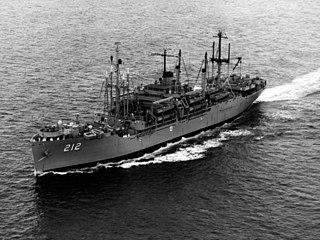
USS Montrose (APA/LPA-212) was a Haskell-class attack transport in service with the United States Navy from 1944 to 1946 and from 1950 to 1969. She was scrapped in 1970.

USS Navarro (APA/LPA-215) was a Haskell-class attack transport of the US Navy. She was of the VC2-S-AP5 Victory ship design type that saw service in World War II and the Vietnam War. Navarro was named after Navarro County, Texas.
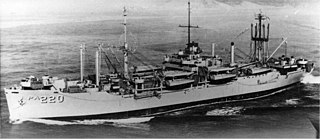
USS Okanogan (APA/LPA-220) was a Haskell-class attack transport that saw service with the US Navy in World War II, the Korean War and the Vietnam War. She was of the VC2-S-AP5 Victory ship design type and named after Okanogan County, Washington.
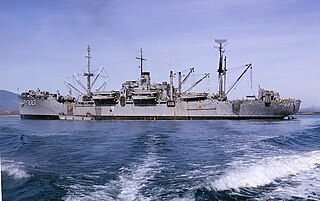
USS Renville (APA-227) was a Haskell-class attack transport that saw service with the US Navy in World War II, the Korean War and the Vietnam War.

USS Bottineau (APA-235) was a Haskell-class attack transport in service with the United States Navy from 1944 to 1947 and from 1951 to 1955. She was scrapped in 1983.

USS Bexar (APA-237/LPA-237) was a Haskell-class attack transport in service with the United States Navy from 1945 to 1970. She was scrapped in 1982.





















